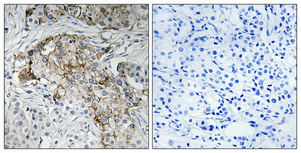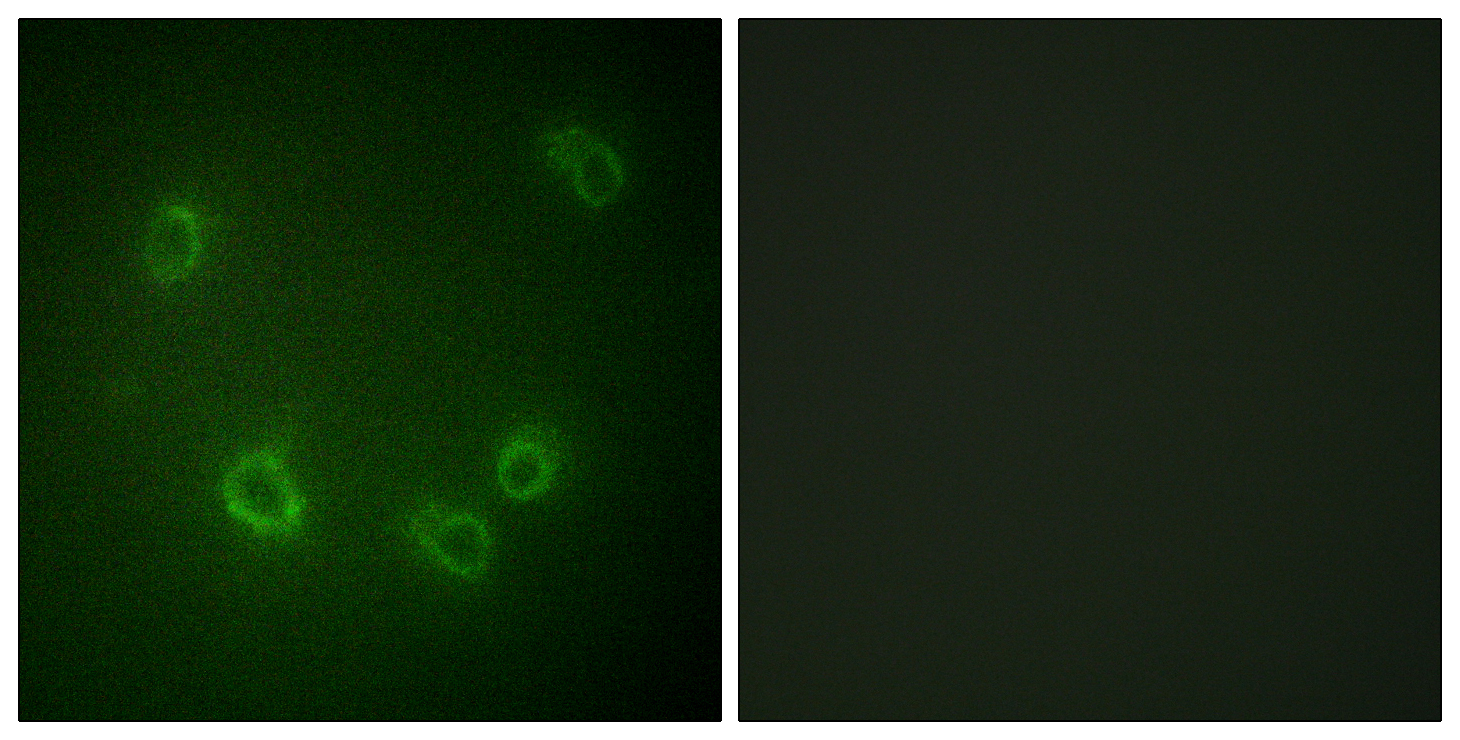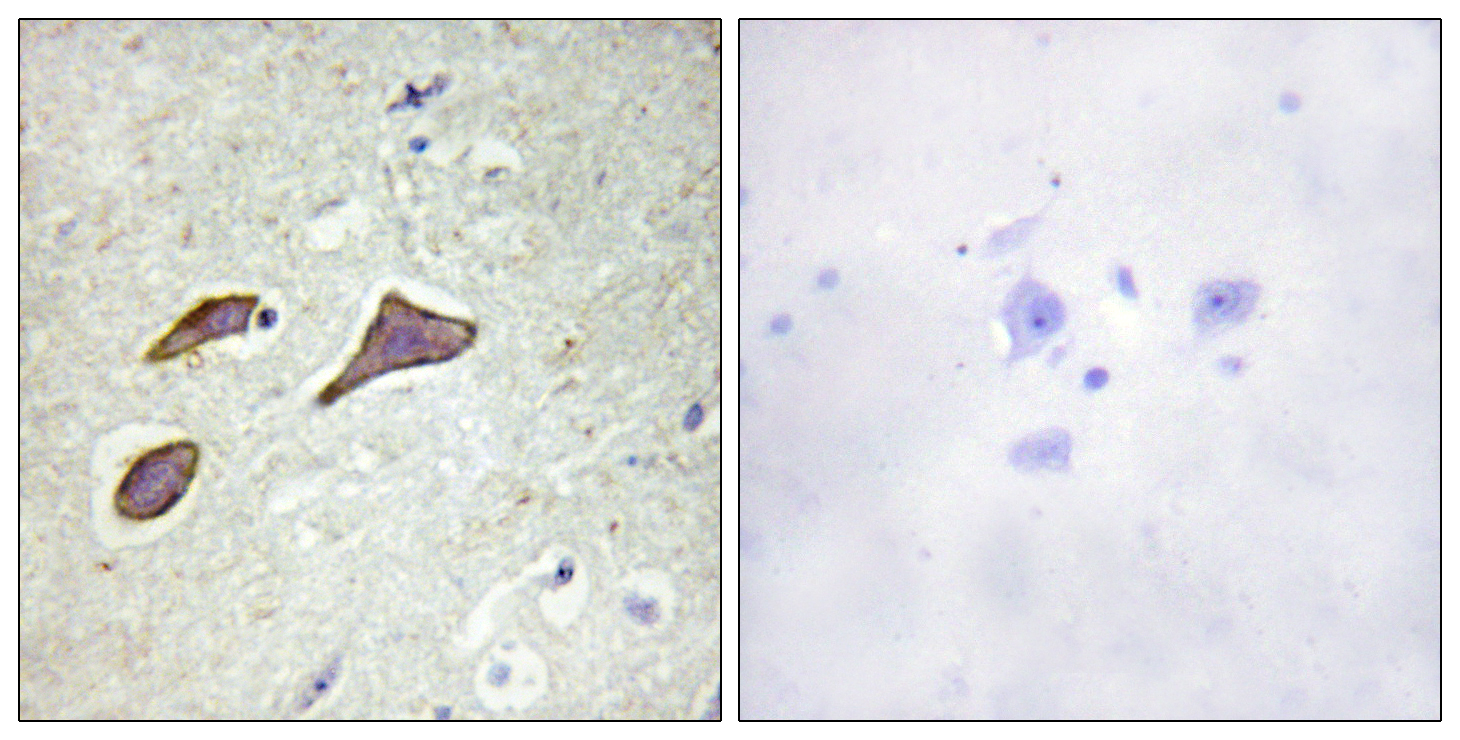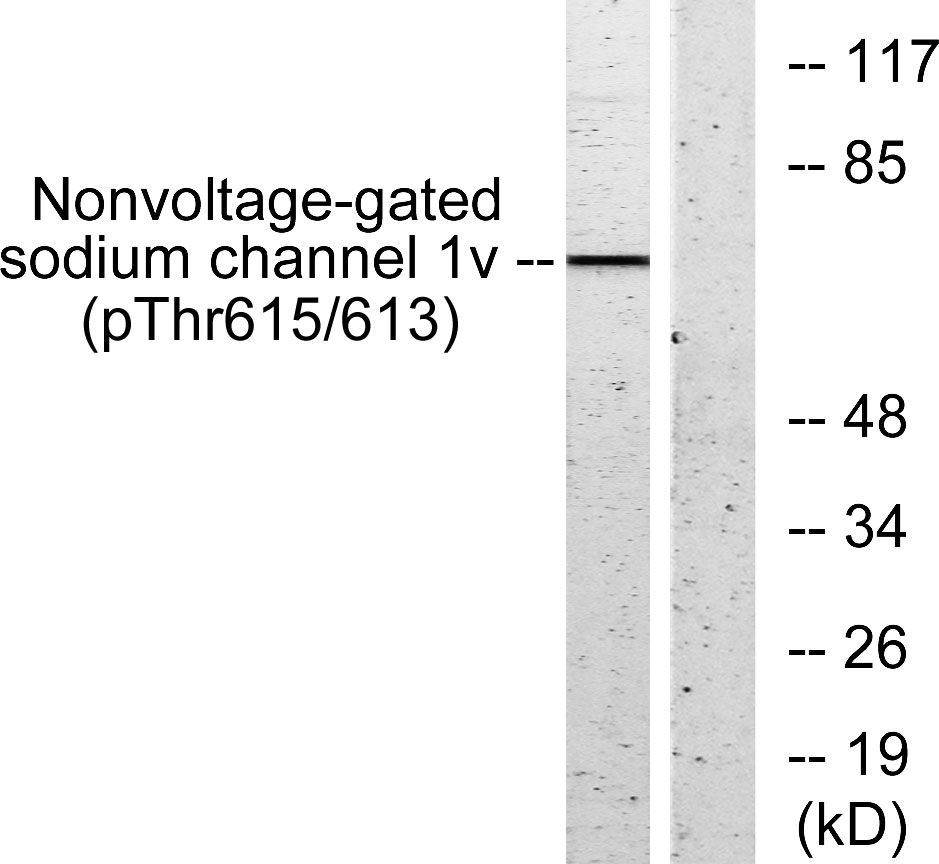ENaC β (phospho Thr615) Polyclonal Antibody
- Catalog No.:YP0941
- Applications:WB;IHC;IF;ELISA
- Reactivity:Human;Mouse;Rat
- Target:
- ENaC β
- Fields:
- >>Taste transduction;>>Aldosterone-regulated sodium reabsorption
- Gene Name:
- SCNN1B
- Protein Name:
- Amiloride-sensitive sodium channel subunit beta
- Human Gene Id:
- 6338
- Human Swiss Prot No:
- P51168
- Mouse Gene Id:
- 20277
- Mouse Swiss Prot No:
- Q9WU38
- Rat Gene Id:
- 24767
- Rat Swiss Prot No:
- P37090
- Immunogen:
- The antiserum was produced against synthesized peptide derived from human Nonvoltage-gated Sodium Channel 1 around the phosphorylation site of Thr615. AA range:581-630
- Specificity:
- Phospho-ENaC β (T615) Polyclonal Antibody detects endogenous levels of ENaC β protein only when phosphorylated at T615.
- Formulation:
- Liquid in PBS containing 50% glycerol, 0.5% BSA and 0.02% sodium azide.
- Source:
- Polyclonal, Rabbit,IgG
- Dilution:
- WB 1:500 - 1:2000. IHC 1:100 - 1:300. IF 1:200 - 1:1000. ELISA: 1:10000. Not yet tested in other applications.
- Purification:
- The antibody was affinity-purified from rabbit antiserum by affinity-chromatography using epitope-specific immunogen.
- Concentration:
- 1 mg/ml
- Storage Stability:
- -15°C to -25°C/1 year(Do not lower than -25°C)
- Other Name:
- SCNN1B;Amiloride-sensitive sodium channel subunit beta;Beta-NaCH;Epithelial Na(+) channel subunit beta;Beta-ENaC;ENaCB;Nonvoltage-gated sodium channel 1 subunit beta;SCNEB
- Observed Band(KD):
- 68kD
- Background:
- Nonvoltage-gated, amiloride-sensitive, sodium channels control fluid and electrolyte transport across epithelia in many organs. These channels are heteromeric complexes consisting of 3 subunits: alpha, beta, and gamma. This gene encodes the beta subunit, and mutations in this gene have been associated with pseudohypoaldosteronism type 1 (PHA1), and Liddle syndrome. [provided by RefSeq, Apr 2009],
- Function:
- disease:Defects in SCNN1B are a cause of autosomal recessive pseudohypoaldosteronism type 1 (PHA1) [MIM:264350]. PHA1 is a rare salt wasting disease resulting from target organ unresponsiveness to mineralocorticoids. There are 2 forms of PHA1: the autosomal recessive form that is severe, and the dominant form which is more milder and due to defects in mineralocorticoid receptor. Autosomal recessive PHA1 is characterized by an often fulminant presentation in the neonatal period with dehydration, hyponatraemia, hyperkalaemia, metabolic acidosis, failure to thrive and weight loss.,disease:Defects in SCNN1B are a cause of Liddle syndrome [MIM:177200]. It is an autosomal dominant disorder characterized by pseudoaldosteronism and hypertension associated with hypokalemic alkalosis. The disease is caused by constitutive activation of the renal epithelial sodium channel.,function:Sodium permeable
- Subcellular Location:
- Apical cell membrane ; Multi-pass membrane protein . Cytoplasmic vesicle membrane . Apical membrane of epithelial cells. .
- Expression:
- Detected in placenta, lung and kidney (PubMed:7762608). Expressed in kidney (at protein level) (PubMed:22207244).
- June 19-2018
- WESTERN IMMUNOBLOTTING PROTOCOL
- June 19-2018
- IMMUNOHISTOCHEMISTRY-PARAFFIN PROTOCOL
- June 19-2018
- IMMUNOFLUORESCENCE PROTOCOL
- September 08-2020
- FLOW-CYTOMEYRT-PROTOCOL
- May 20-2022
- Cell-Based ELISA│解您多样本WB检测之困扰
- July 13-2018
- CELL-BASED-ELISA-PROTOCOL-FOR-ACETYL-PROTEIN
- July 13-2018
- CELL-BASED-ELISA-PROTOCOL-FOR-PHOSPHO-PROTEIN
- July 13-2018
- Antibody-FAQs
- Products Images

- Immunohistochemical analysis of paraffin-embedded Human breast cancer. Antibody was diluted at 1:100(4° overnight). High-pressure and temperature Tris-EDTA,pH8.0 was used for antigen retrieval. Negetive contrl (right) obtaned from antibody was pre-absorbed by immunogen peptide.

- Immunofluorescence analysis of COS7 cells, using Nonvoltage-gated Sodium Channel 1 (Phospho-Thr615) Antibody. The picture on the right is blocked with the phospho peptide.

- Immunohistochemistry analysis of paraffin-embedded human brain, using Nonvoltage-gated Sodium Channel 1 (Phospho-Thr615) Antibody. The picture on the right is blocked with the phospho peptide.

- Western blot analysis of lysates from HeLa cells, using Nonvoltage-gated Sodium Channel 1 (Phospho-Thr615) Antibody. The lane on the right is blocked with the phospho peptide.



